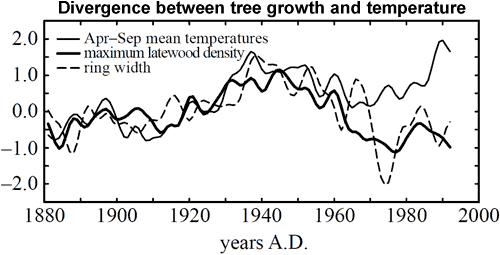The hockey stick divergence problem
Tree growth is sensitive to temperature. Consequently, tree-ring width and tree-ring density, both indicators of tree growth, serve as useful proxies for temperature. By measuring tree growth in ancient trees, scientists can reconstruct temperature records going back over 1000 years. Comparisons with direct temperature measurements back to 1880 show a high correlation with tree growth. However, in high latitude sites, the correlation breaks down after 1960. At this point, while temperatures rise, tree-ring width shows a falling trend (a decline, if you will). This divergence between temperature and tree growth is called, imaginatively, the divergence problem.
The divergence problem has been discussed in the peer reviewed literature since the mid 1990s when it was noticed that Alaskan trees were showing a weakened temperature signal in recent decades (Jacoby 1995). This work was broadened in 1998 using a network of over 300 tree-ring records across high northern latitudes (Briffa 1998). From 1880 to 1960, there is a high correlation between the instrumental record and tree growth. Over this period, tree-rings are an accurate proxy for climate. However, the correlation drops sharply after 1960. At high latitudes, there has been a major, wide-scale change in tree-growth over the past few decades.

Figure 1: Twenty-year smoothed plots of tree-ring width (dashed line) and tree-ring density (thick solid line), averaged across a network of mid-northern latitude boreal forest sites and compared with equivalent-area averages of mean April to September temperature anomalies (thin solid line). (Briffa 1998)
Has this phenomenon happened before? In other words, can we rely on tree-ring growth as a proxy for temperature? Briffa 1998 shows that tree-ring width and density show close agreement with temperature back to 1880. To examine earlier periods, one study split a network of tree sites into northern and southern groups (Cook 2004). While the northern group showed significant divergence after the 1960s, the southern group was consistent with recent warming trends. This has been a general trend with the divergence problem - trees from high northern latitudes show divergence while low latitude trees show little to no divergence. The important result from Cook 2004 was that before the 1960s, the groups tracked each other reasonably well back to the Medieval Warm Period. Thus, the study suggests that the current divergence problem is unique over the past thousand years and is restricted to recent decades.
This suggests the decline in tree growth may have an anthropogenic cause. A thorough review of the many peer reviewed studies investigating possible contributing factors can be found in On the ’divergence problem’ in northern forests: A review of the tree-ring evidence and possible causes (D’Arrigo 2008). Some of the findings:
Various studies have noted the drop in Alaskan tree-growth coincides with warming-induced drought. By combining temperature and rainfall records, growth declines were found to be more common in the warmer, drier locations.
Studies in Japan and Bavaria suggest increasing sulfur dioxide emissions were responsible.
- As the divergence is widespread across high northern latitudes, Briffa 1998 suggests there may be a large scale explanation, possibly related to air pollution effects. A later study by Briffa proposed that falling stratospheric ozone concentration is a possible cause of the divergence, since this observed ozone decline has been linked to an increased incidence of ultraviolet (UV-B) radiation at the ground (Briffa 2004).
Connected to this is global dimming (a drop in solar radiation reaching the ground). The average amount of sunlight reaching the ground has declined by around 4 to 6% from 1961 to 1990.
One study suggests that microsite factors are an influence on whether individual trees are vulnerable to drought stress. Eg - the slope where the tree is located, the depth to permafrost and other localised factors (
Wilmking 2008). This paper amusingly refers to the divergence problem as the "divergence effect" so as "to not convey any judgement by the wording" (you wouldn't want to offend those overly sensitive Alaskan trees).
There is evidence for both local and regional causes (e.g. drought stress) as well as global scale causes (e.g. global dimming). It's unlikely there's a single smoking gun to explain the divergence problem. More likely, it's a complex combination of various contributing factors, often unique to different regions and even individual trees.
In past weeks (even predating "Climategate"), there has been a kneejerk reaction among skeptics to assume that climate scientists are conspiring to cover up the divergence problem. Unfortunately most critics fail to acquaint themselves with the actual science before voicing their conspiracy theories. A perusal of the many peer reviewed papers since 1995 (conveniently summarised in D’Arrigo 2008) reveal the following:
The divergence problem is a physical phenomenon - tree growth has slowed or declined in the last few decades, mostly in high northern latitudes.
The divergence problem is unprecedented, unique to the last few decades, indicating it's cause is anthropogenic.
The cause is likely to be a combination of local and global factors such as warming-induced drought and global dimming.
Tree-ring proxy reconstructions are reliable before 1960, tracking closely with the instrumental record and other independent proxies.
Posted by John Cook on Tuesday, 1 December, 2009


